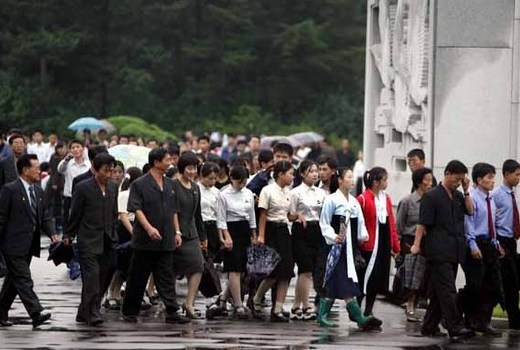 |
|
Pyongyang residents make exit from Gumsusan Memorial Palace on September 9, after having paid their tribute to Kim il-sung.
|
The tone of the Northern official present at the team’s welcoming ceremony was commanding and full of self-confidence. "The North gave rice and relief supplies to the South after the floods of 1984," he said. "Now it is us who faces difficulty, and we are receiving aid accordingly." He spoke the words with dignity and self-possession. As the tension of the initial meeting with their Northern hosts was dissipated by the effects of alcohol, I spoke up: "I am curious in regards to the socialist legal system. I would like to observe a North Korean courtroom." To this, the official was taken aback. "To everything there is a proper order," he said, politely rejecting the request. The next day, when a photographer requested to see an area that was damaged by flooding, he received the same polite refusal from Northern officials. On September 9, the 58th anniversary of North Korea’s foundation, an unexpected window of North Korean society opened. After nearly wrapping up their three-day schedule, I told the North Korean official over dinner that I would like to see Pyongyang on September 9, requesting permission to visit the Gumsusan Memorial Palace. After lengthy discussion amongst themselves, the Northern hosts consented. Rain fell thinly on the morning of September 9. Though it was early, mourners from across the country had gathered in a long line within the roughly 400-by-200-meter plaza of the Memorial Palace, a space designed to honor Kim Il-sung and Kim Jong Il. Our group of visitors was driven to the palace, stopping first at the entrance checkpoint. After getting out of the car and passing through inspections, we climbed back into the car and continued forward. Within five minutes, the colossal pillars of the Memorial Palace came into view, with its Western-style walls topped by an Eastern-style roof. I felt a bit of trepidation, and not simply because the checkpoint guard was holding a Kalishnikov AK-47 in the ready position. Upon passing through the entrance, I encountered a more than three-meter tall statue of Kim Il-sung. Beneath the glaring fluorescent lighting of the hall, the melody of a funeral march could be heard. Standing in three columns, the mourners bowed their heads in front of the statue before entering the "hall of tears." With the ceiling 5 meters from the ground, the assembled mourners took an elevator in order to view Kim Il-sung’s body. The guards, all of whom appeared to be taller than 180 cm (5’10") glared leery-eyed at the "alien" guests. The elevator doors opened and the citizens that had finished paying their respects to Kim Il-sung’s embalmed corpse began making their exit. Most of them were dressed neatly in traditional Korean hanbok. Many women among the mourners wiped away tears with their coat strings. Before entering the room, our group had to pass through a sterilizing burst of air. The room looked to be more than 15 by 15 meters in size. The illumination came in at under 20 lux, or about as bright as a poorly lit pub. In the center of the room, embalmed in a glass case, lay the body of Kim Il-sung, revolutionary and politician. Not unlike Lenin, who wanted to be buried next to his mother’s grave in Saint Petersburg but ended up embalmed instead, and Ho Chi Minh, who had vainly hoped his ashes would be sprinkled in Vietnam, Kim Il-sung also found his final resting place to be a display case in public view. Though pale, his skin gave a feeling of resilience, as if he were still alive. Only his face was visible, the remainder of his body covered in whitlow grass. The illumination placed upon him gave his skin a certain translucence. Four visitors stood in a row at the foot of the coffin, bowing their heads in silent prayer. The group then took up position on the left side, at his head, and then on the right side of the casket, offering their respects at each position. The solemn melody continued to drift in from the hall. After making this circuit in such a fashion, the mourners left the room in groups of four. In the surrounding rooms, the medals and honorary degrees Kim Il-sung received from across the world were on display. Emblazoned on each were words such as The Union of Soviet Socialist Republics; The German Democratic Republic; Romania; the names of old socialist nations. A map of the path Kim Il-sung had taken on his official visits, as well as pictures of the automobiles and trains he had taken, were on display. Thirty minutes later, upon exiting, the square was still bustling. On the streets leading to Pyongyang Airport, the slogan "Our Leader is Eternally With Us" could be seen everywhere. Looking down from the Tupolev-154 airplane as it took off, the city still appeared to be very much the one that Kim Il-sung had created. It felt as if from the first day to the very last, the thing that greeted us had been the portrait of the "Dear Leader." translated by Daniel Rakove





